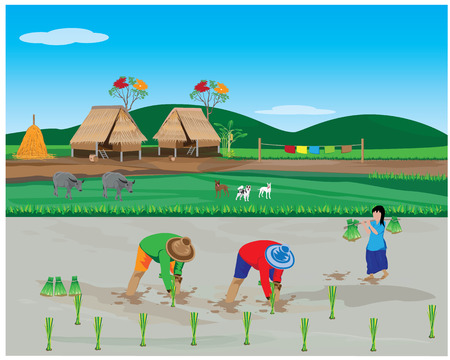Introduction to Composting in India
Composting holds a deep-rooted significance in Indian agriculture, with its origins tracing back to ancient times. In the rural heartlands of India, composting was not merely a farming technique but a way of life woven into the very fabric of daily existence. The age-old practice of transforming organic waste into nutrient-rich soil amendments has long been recognised by Indian communities for its sustainable benefits. Historical texts, including those related to Ayurveda, mention the use of decomposed organic matter to enhance soil fertility and promote healthy crop growth. In traditional Indian villages, compost pits were a common sight and every household played an active role in recycling kitchen scraps, animal dung, and agricultural residues. This closed-loop system ensured minimal waste and maximised the use of natural resources—values that resonate deeply within Indian culture. By understanding these ancient practices, we can appreciate how composting supported both the spiritual and practical aspects of rural life, laying the foundation for what is now known as Ayurvedic farming.
Principles of Ayurveda and Sustainable Agriculture
Ayurveda, the ancient Indian system of holistic health, extends its wisdom beyond the human body to encompass nature and agriculture. Rooted in the Sanskrit words “Ayur” (life) and “Veda” (knowledge), Ayurveda emphasizes balance, harmony, and sustainability in all aspects of life. When applied to farming, these principles translate into practices that nurture not only crops but also the land itself.
Ayurvedic philosophy teaches that health is achieved by balancing the three doshas—Vata, Pitta, and Kapha—which represent elements of air, fire, and earth/water respectively. This concept of balance is mirrored in sustainable agriculture practices, where maintaining soil fertility, moisture levels, and organic matter is crucial for healthy crop production.
The tradition of composting in Ayurvedic farming arises from the same holistic approach. Organic composting recycles natural waste into nutrient-rich manure, thus restoring soil health without synthetic chemicals. This aligns with the Ayurvedic belief that health comes from pure, unadulterated sources. For generations, Indian farmers have practiced “Jeevamrutha,” “Panchagavya,” and other indigenous composting methods to enhance soil vitality naturally.
Philosophical Connections: Ayurveda and Composting
| Ayurvedic Principle | Application in Farming | Composting Connection |
|---|---|---|
| Balance (Tridosha) | Maintain balanced soil nutrients | Compost restores nutrient equilibrium |
| Purity (Satva) | Avoid chemical inputs; focus on natural amendments | Use of organic matter ensures purity |
| Sustainability (Dinacharya/Ritucharya) | Seasonal crop rotation and resource renewal | Continuous composting cycles support sustainability |
| Interconnectedness (Prakriti) | Treat soil, plants, animals as one ecosystem | Composting integrates all farm residues into one cycle |
Holistic Health: Soil and Crop Management
Just as Ayurveda considers the mind-body-spirit connection essential for wellness, it encourages farmers to see soil as a living entity. Healthy soil teeming with microbes supports robust crops, which then provide nutritious food. This cyclical relationship forms the backbone of traditional Indian agriculture where composting is not just a technique but a way to honor the land’s vitality.
Community Practice: Passing Down Knowledge
Ayurvedic farming is deeply woven into rural Indian communities. Knowledge about composting—from selecting organic ingredients to timing application—is passed down through generations. Farmers often gather for seasonal festivals or “Krishi Melas” to share experiences and strengthen communal bonds around sustainable practices.

3. Traditional Composting Techniques in Ayurvedic Farming
In the rich agricultural heritage of India, traditional composting techniques hold a central place, especially within the framework of Ayurvedic farming practices. Over centuries, Indian farmers have developed indigenous methods to enrich soil fertility and promote plant health, deeply rooted in local wisdom and eco-friendly principles. The most revered ingredient in these methods is cow dung, known as “Gobar” in Hindi, which is celebrated for its potent microbial content and ability to rejuvenate the earth. Cow dung, when mixed with agricultural waste and left to decompose naturally, creates a nutrient-dense manure that has been used across rural India for generations.
Panchagavya: The Sacred Elixir
A unique Ayurvedic preparation called Panchagavya (पञ्चगव्य), which translates to “five products of the cow,” is another cornerstone of traditional composting. This potent bio-enzymatic mixture includes cow dung (Gobar), cow urine (Gomutra), milk (Doodh), curd (Dahi), and ghee (clarified butter). Farmers often ferment Panchagavya for several days, allowing beneficial microbes to multiply. When applied to fields, it not only enriches the soil but also enhances crop resilience against pests and diseases. Panchagavya has gained immense popularity among organic practitioners in states like Tamil Nadu, Kerala, and Karnataka.
Other Indigenous Bio-Enzyme Preparations
Beyond Panchagavya, various regions boast their own compost recipes. For instance, in Maharashtra and Gujarat, Jeevamrut (जीवामृत) is prepared using cow dung, cow urine, jaggery (Gud), pulse flour (Besan or Dal ka Atta), and soil from beneath a healthy Banyan tree. This liquid manure acts as a growth promoter and microbial booster for crops. In Andhra Pradesh and Telangana, Kashayam—herbal decoctions made from locally available plants—are added to compost piles to enhance decomposition and pest resistance.
Cultural Significance and Community Involvement
These time-honoured techniques are more than just agricultural practices; they represent community-driven knowledge systems passed down through generations. Compost pits or heaps are often built collectively by families or even entire villages during seasonal cycles. Festivals like Makar Sankranti and Baisakhi witness communal preparation of compost materials as part of traditional rituals. This synergy between cultural values and sustainable farming exemplifies how Ayurveda-inspired composting continues to shape Indian agriculture today.
4. Historical Significance in Crop Health and Productivity
Composting has played a pivotal role in Indian agriculture, especially under the guidance of Ayurvedic farming traditions. Across centuries, Indian farmers have recognized the importance of organic matter in sustaining soil health and improving crop yields. Ancient texts like the Vrikshayurveda and Krishi-Parashara provide detailed references to composting methods and their direct influence on agricultural productivity. Through these texts and local practices, composting became a time-tested tool for maintaining fertile soils across various agro-climatic zones.
References from Historical Texts
The Vrikshayurveda (Science of Plant Life), attributed to Surapala around the 10th century CE, highlights the use of organic manure and compost as essential for healthy plant growth. The treatise describes preparing compost pits, layering plant residues, cow dung, ashes, and water—methods still relevant in rural India. Similarly, Krishi-Parashara, dating back to 100 BCE, mentions using farmyard manure to rejuvenate exhausted soils and increase grain output. These historical documents not only emphasize composting but also link it closely to Ayurvedic principles of balance and harmony in nature.
Case Studies: Regional Practices and Outcomes
Farmers from diverse regions such as Punjab, Kerala, Maharashtra, and West Bengal have historically adapted composting to suit their unique ecological conditions. For example, in Kerala’s wet climate, coconut husk composting was practiced to enrich sandy soils. In contrast, farmers in Punjab mixed green manure with cattle dung to restore fertility after intensive wheat-paddy cycles. Over generations, these methods led to improved soil structure and sustainable yields.
Impact on Soil Fertility and Crop Yields: Regional Insights
| Region | Traditional Composting Material | Observed Benefit | Crops Impacted |
|---|---|---|---|
| Punjab | Cattle dung + Green manure | Enhanced nitrogen content; increased wheat & rice yields | Wheat, Rice |
| Kerala | Coconut husk + Leaf litter | Improved moisture retention; better root crops yield | Coconut, Tuber crops |
| Maharashtra | Sugarcane trash + Animal waste | Higher organic carbon; robust sugarcane growth | Sugarcane |
| West Bengal | Paddy straw + Cow dung | Soil aeration; reduced pest infestation in rice fields | Paddy (Rice) |
Community Wisdom Transmitted Across Generations
This legacy of composting is more than just a farming technique—it is part of India’s agricultural heritage. Elders in farming communities often narrate stories of “mitti ki sehat” (soil health) being revived by natural means. By observing the positive changes year after year—from richer harvests to fewer crop diseases—communities continued refining their composting recipes based on local resources and climatic needs.
Role in Preserving Indigenous Seeds and Agro-biodiversity
Composting has played a pivotal role in the preservation of indigenous seeds and the enhancement of agro-biodiversity within Ayurvedic farming traditions across India. Historically, Indian farmers have relied on time-tested composting techniques to nurture their crops and maintain soil vitality, a practice deeply embedded in the ethos of Ayurveda. By using organic matter sourced from their immediate environment—such as cow dung, farm residues, and green leaves—farmers create nutrient-rich compost that aligns with local ecological cycles. This approach not only supports crop growth but also fosters conditions where native seed varieties can thrive.
Safeguarding Native Seeds through Traditional Practices
The use of compost in Ayurvedic farming enables farmers to maintain the genetic purity and vigor of indigenous seeds. Unlike chemical fertilizers, which can disrupt soil health and diminish seed resilience, traditional compost enriches the soil microbiome, allowing native plant varieties to express their unique characteristics. This is especially crucial in India, where diverse agro-climatic zones support a wide array of local crops such as millets, pulses, and heritage rice varieties. Composting thus acts as a natural shield against the homogenization of agriculture brought about by high-yield hybrid seeds and synthetic inputs.
Strengthening Local Farming Systems
Ayurvedic principles emphasize balance and sustainability—values mirrored in composting practices that recycle on-farm biomass back into the earth. This cyclical process reduces dependence on external resources and empowers farming communities to be self-reliant. By nurturing the soil with compost, farmers enhance the resilience of their fields to pests, diseases, and changing weather patterns. The result is a robust local food system that can withstand external shocks while preserving centuries-old agricultural wisdom.
Community-led Conservation Initiatives
Across rural India, many farmer collectives—especially women’s groups—have revived traditional composting methods as part of broader seed-saving movements. These grassroots efforts are often intertwined with festivals and rituals celebrating seed diversity, reinforcing social bonds and cultural identity. Such initiatives highlight how composting is more than just an agronomic technique; it is a community-driven approach to safeguarding both biodiversity and livelihoods for future generations.
6. Community-driven Composting Practices
Across India, composting has always been more than a solitary farm activity; it is deeply rooted in community life and collective wisdom. Traditionally, rural communities have come together to produce organic manure, sharing both resources and knowledge. Such practices not only strengthen social bonds but also ensure the sustainability of Ayurvedic farming techniques.
Village Initiatives: Reviving Traditional Wisdom
Many villages in states like Kerala, Maharashtra, and Uttar Pradesh have revived traditional composting methods through community-led initiatives. For example, local panchayats often organize workshops where elder farmers demonstrate age-old composting techniques using cow dung, green leaves, and household waste. These interactive sessions create platforms for intergenerational knowledge transfer, making sure that young farmers inherit practical wisdom rooted in Ayurveda.
The Pivotal Role of Women in Composting
Women have historically played a central role in managing household and farm waste. In many regions, women’s groups take charge of collecting biodegradable materials and turning them into nutrient-rich compost for herbal crops. Their hands-on involvement ensures that ancient recipes for compost—often passed down orally—are preserved and practiced effectively. These women are not just practitioners but also educators, teaching their children and neighbours about the importance of compost in maintaining soil health as prescribed by Ayurvedic texts.
Self-Help Groups (SHGs): Agents of Change
The rise of Self-Help Groups (SHGs) has significantly boosted community-driven composting in recent decades. SHGs composed mainly of women, such as Kudumbashree in Kerala or Mahila Mandals across North India, spearhead campaigns to promote home composting pits and vermicomposting units. By pooling micro-savings, these groups invest in training sessions and small infrastructure projects that make composting accessible to every household.
Sharing Knowledge, Sustaining Traditions
Community events like “compost melas” (fairs) are organised where farmers and homemakers share success stories and innovative ideas for improving compost quality. These gatherings foster a sense of pride and continuity in indigenous agricultural practices, echoing the holistic approach of Ayurveda that values harmony between humans and nature.
Through these collective efforts—be it village councils, women’s leadership, or SHGs—composting remains a vibrant tradition in Indian agriculture. Such models not only honour the historical legacy of Ayurvedic farming but also empower communities to create sustainable futures together.
7. Contemporary Relevance and Reviving Ayurvedic Traditions
In todays rapidly changing agricultural landscape, there is a renewed interest across India in embracing the sustainable wisdom of our ancestors. Modern movements are emerging that aim to revive the age-old practices of composting rooted in Ayurveda, blending traditional knowledge with contemporary needs. This revival is not just about looking back; it is about harnessing the time-tested methods of Ayurvedic farming to address present-day challenges such as soil degradation, chemical dependency, and declining crop diversity.
Bridging Past Wisdom and Present Aspirations
Across rural and urban India, farmers, NGOs, and local communities are coming together to reintroduce composting techniques like Panchagavya, Jeevamrutha, and other organic amendments prescribed in ancient texts. These efforts reflect a recognition that our forefathers had developed holistic systems that nourished both the earth and its people. By tapping into these traditions, today’s practitioners aim to create farming ecosystems that are resilient, productive, and environmentally sound.
The Role of Education and Community Participation
Workshops, training programs, and community initiatives are being organized to teach younger generations about the significance of organic waste management and natural soil enrichment. Many schools and colleges now include practical sessions on composting, ensuring that this vital knowledge is passed down effectively. Local panchayats and cooperative societies also play a crucial role by supporting farmers in adopting Ayurvedic composting practices suited to regional agro-climatic conditions.
Sustainability for the Future
By combining modern scientific insights with ancient Ayurvedic wisdom, Indian agriculture stands at the threshold of a sustainable transformation. Composting—once an integral part of our heritage—is gaining new relevance as a tool for ecological balance, healthy food production, and rural prosperity. The journey towards reviving these traditions is not without challenges, but it promises a future where farming aligns harmoniously with nature—just as envisioned by our ancestors centuries ago.


